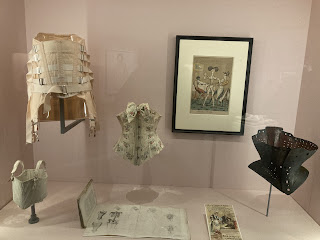Some of you might remember my scathing post about the recent Barbie film. I did however, commend them on the props and set, and I'm not sure I mentioned it but the end credits had a montage of the history of Barbie dolls through the ages, arguably the best part of the film. Well, like the film, this exhibition begins at the beginning: Barbie No.1. Iconic, resplendent, exceedingly pale, with a platinum high ponytail, graphic eye shadow, red lips, red nails, monochrome swimsuit, kitten heels. Calm, poised, sunglasses in hand. Mesmerising and transcending fashion and time. Luckily, this exhibition does not then disintegrate into a puddle of self congratulation, even as it does show the spirit of Barbie compromised for the good of society.
After all, as the exhibition coyly alludes, Barbie was inspired by a novelty German sex doll, Lilli - a sexually provocative curvy doll which men could dress in different outfits, festoon their trucks with, joke gift, or generally see as a tool for their misogyny and superiority. How empowering then, that this was usurped by Ruth Handler, the creator of Barbie. Young girls now had the option to play with aspirational (albeit impossibly beautiful and successful) adult dolls rather than doll versions of little girls and babies. I couldn't help but wonder if by allowing Barbie to be darker, curvier, shorter, disabled, humbled, and in summary, relatable, the very essence of Barbie was eroded. As once upon a time, being a model meant one gasped in awe, and today one most likely replies, yeah I'm also a model. These unattainable achievements were once the stuff of child's play, but today we all have apps and editing tools and skills which can be learned for free online or watched and absorbed via tutorials, and every condition or mood has its own social media ambassador. One needn't play alone and ascribe role playing when one can hop online and have a reddit thread with real people... And yet, Barbie still holds her allure. Last year the film was able to ignite 'Barbiecore'; there is still a thirst for the unapologetic Dream House, pink outfits, big hair - joy in the feminine power and its ability to threaten and reduce men.
The various iterations of Ken pale into insignificance next to the hundred Barbie dolls. Always officially no more than Barbie's boyfriend, the unspoken and seemingly denied gay identity of some Kens - particularly "earring magic Ken" who some rather persuasively insist wears a cock ring on his necklace, are no more than a side show to Barbie's world.
A world where home ownership began before it began for real life women (women in US, up until almost the mid 1970s, were still denied mortgage applications unless they were married; Barbie homes however were introduced in the 1960s.)
BARBIE FASHION DINING ROOM
SET, 1984
BARBIE MAGICAL MANSION, 1990
BARBIE DREAM FURNITURE COLLECTION, 1978
The friends, who came to include by the 1960s "Coloured Francie" and more ‘on trend’ afro haired friends into the 70s, resulted finally in the first ever Black Barbie in 1980. Perhaps some latent 'othering' with the tagline on the box, "She's black! She's beautiful! She's dynamite!" But no use to nitpick when the general direction was clearly that of progress. Culminating in an animated Barbie anti racism video in 2020 following the George Floyd murder.
The interesting thing about the Design museum, and I did have a quick look around upstairs too, is the emphasis on branding, marketing and identity. In spite of the capitulations to a changing world and a changing audience, Mattel has succeeded in keeping hold of an unmistakable Barbie heartbeat. Perhaps it's the endearingly vacant gaze of a Barbie. Never haughty, yet always confident and knowing. A certain tilt of the head, or the long neck and splayed out arms.
The logo has come full circle, returning to its original 1959 script.
TWIST 'N TURN BARBIE DOLL, 1967

BEAD BLAST BARBIE DOLL, 1997
WALK LIVELY BARBIE DOLL, 1972
FASHION QUEEN
BARBIE DOLL, 1963
BARBIE DOLL, WEARING
'REGISTERED NURSE,
1961
GUINEVERE, 1964
CINDERELLA', 1964
My favourite. The 1964 “Little Theatre” edition came with a script book, with doll-sized theatrical costumes (available separately, naturally.)
Barbie is on at The Design Museum London until 23rd February 2025
Recommended: 9/10





























































